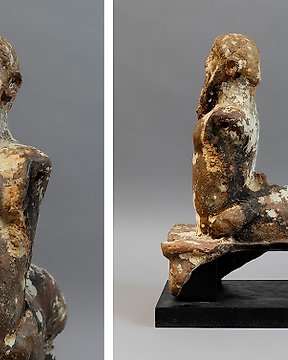
Fenício Terracota Ex-Voto ou Ídolo representando um Tritão. Séculos 6 a 4 aC. 32 cm H. Procedência antiga. Exportação
N.º 84568353

N.º 84568353

Sarcophagus Fragment
- Thermoluminescense Test -
- Ex. Christies -
- Important Piece! -
Ancient Greek, Clazomenae, Mid 6th-mid 5th century BC.
Terracotta and pigments.
6.6 kg total, 42.5 cm.
PROVENANCE: Property of a London gentleman; ex Cybele Gallery, Paris, France; formerly with Christie's in 2006; previously in a private English collection.
CONDITION: Intact, see photos.
PARALLELS: See Cook, R.M., Clazomenian Sarcophagi, Mainz, 1981, for discussion of the sarcophagi produced at the city of Clazomenai,
DESCRIPTION:
A carved ceramic fragment with white slip and black pigment field to the lateral flange; white vertical band with painted meander pattern to one narrow edge; painted guilloche to the wider face terminating in a profile male bust wearing a conical hat with spirals and pellets, possibly the tutelary god Apollo; mounted on a custom-made stand. The sarcophagus is made from a coarse pink clay with a white slip covering, the style for which the city of Clazomenae is known.
The interlacing motif developing on the front face corresponds to a decorative pattern that can be seen on Classical Greek clazomenian sarcophagi, such as the one in the Altes Museum in Berlin or in the museums of Smyrna: they are bordered with grooved fretwork like the one shown here running along their long sides, while on the short sides are depictions of divinities, conch shells and homoerotic scenes of young aristocrats. The side retains Greek geometric fretwork decoration.
Clazomenes or Clazomene was an ancient Ancient Greek port polis on the Aegean coast of Anatolia. The painted terracotta sarcophagi discovered in the necropolis of the local archaeological site are the most prized works of Ionian painting from the 6th century BC. Many of them are kept in the neighbouring museums of Smyrna.
Clazomenes was an ally of the Ionian League (or Dodecapolis, which was the confederation of the twelve cities). During the Ionian revolt against the Persians in the early 5th century BC, Clazomenes was moved to an island just off the coast. According to tradition, Alexander the Great connected the island to the mainland by means of an artificial ramp. The city of Urla, which is also a district of the province of Smyrna in Turkey, is located on the site where it once stood.
Notes:
The piece includes authenticity certificate.
The piece includes Spanish Export License.
The seller guarantees that he acquired this piece according to all national and international laws related to the ownership of cultural property. Provenance statement seen by Catawiki.
Como comprar na Catawiki
1. Descubra algo especial
2. Faça a licitação vencedora
3. Faça um pagamento seguro